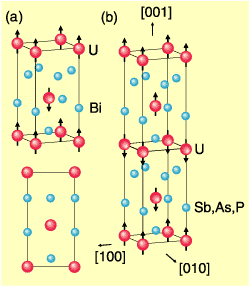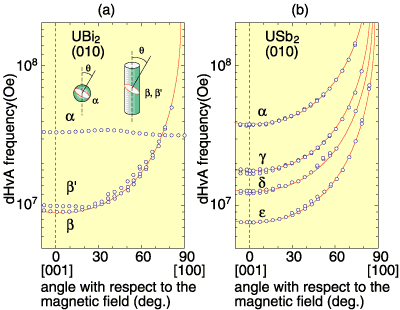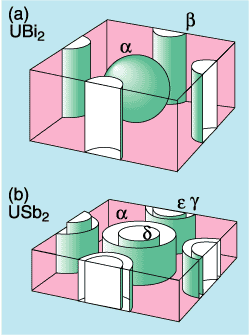Metals are good conductors of heat and their conductivity is due to the conduction electrons. The properties of metals are mainly due to the nature of the conducting electrons. Fermi surfaces show the space distributions of the conducting electrons' momenta. Fermi surfaces indicate the features of super-conductivity or electrical conductivity etc.
In UX2 (X=Bi, Sb, As, P), we found for the first time cylindrical two-dimensional Fermi surfaces in uranium compounds. For these two-dimensional Fermi surfaces, there are insulating layers between conducting layers, and it is a characteristic that conduction is largely anisotropic. The two-dimensional Fermi surfaces were previously found in cuprate high-temperature superconductors or organic conductors. It is easily understood from their crystal structures that such compounds have two-dimensional Fermi surfaces. By the way, the easiest example, which shows isotropic conduction, are the spherical Fermi surfaces of alkaline metal or copper.
UX2 (X=Bi, Sb, As, P) have tetragonal crystal structures with a long length along the [001] direction and so it seems to be difficult to think that they have two-dimensional conduction (Fig. 1-8). Figure 1-9 shows the experimental result that there are cylindrical two-dimensional Fermi surfaces. These compounds show antiferromagnetic ordering near room temperature (180 - 280K). UX2 (X=Sb, As, P) especially have magnetic structure with a double unit cell and then the magnetic structure becomes much longer along [001] (Fig. 1-8). Thus, the reciprocal lattice of the crystal (the reciprocal lattice corresponds not to distance but to momentum, and the length of the reciprocal lattice is inversely proportional to the length of the real crystal lattice) or the Brillouin zone becomes half of that in the paramagnetic state. It is very flat along [001] (Fig. 1-10). Namely, the Fermi surfaces in the paramagnetic state are cut in half along [001] and cylindrical Fermi surfaces appear.
Once again an unusual property viz., that two-dimensional Fermi surfaces appear due to the antiferromagnetism, becomes obvious. |


